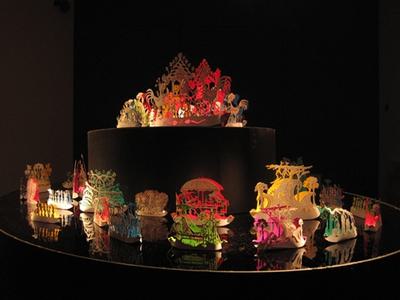Transit of Venus Spex
By
Helen Snell
2016
Helen Snell
- Sculpture
- Craft and Design
- Mixed Media
- Digital and New Media Art
- Socioeconomic Structures & Consumerism
- Science & Technology
- Global Perspectives & Multiculturalism
- Environment & Sustainability
- Social & Political
- Heritage & Archives
- Exploration
- Native
- Indigenous
- Residency
- Exhibition
- Circle
- Globe
- Museum
Dimensions
various
Currently exhibited at the National Museum of the Royal Navy as part of A Long Shadow exhibition . During my residency it has been fascinating to look in detail at John Webber’s engravings which were commissioned to provide an objective and academic account of Cook's voyage, and to transmit a degree of scientific knowledge. Close study of the figures in the backgrounds is very revealing. Figures are often in classical poses, more in keeping with Greek and Roman sculpture than the real life of indigenous peoples. Interactions between Europeans and natives are predictably stylised, European sensibilities and tastes are imposed, reinforcing the sense of European vanity.
The image of native women is as submissive, and available, strongly reminiscent of paintings or tapestries depicting the Rape of the Sabines or the colouriful decorative renderings of Tahitian Women in Gauguin's paintings.
The group of figures in the far right corner of the engraving Reception’ at Hapaee ( one of the Friendly Islands, Tonga) particularly interested me and has inspired the work Transit of Venus Spex, Goggles and devices for the enhancement of vision proliferate in the museum collections.
On June 3, 1769, Captain James Cook recorded the transit of Venus on the island of Tahiti during Cook's first voyage around the world.
Helen Snell
Helen Snell
Helen Snell
Helping Artists Keep Going
Axis is an artist-led charity supporting contemporary visual artists with resources, connection, and visibility.







